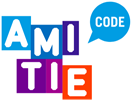AMITIE CODE project focuses on raising awareness among European citizens and institutions about migration, development and human rights, topics that are, now more than ever, the centre of global debate.
We are persuaded that any properly informed citizen is able to perceive, recognize and reject the stereotypes which often hinder integration processes. Therefore communication activities become a key tool to turn every citizen into an accountable individual likely to reach out to other people.
The project communication plan focuses on dissemination of project results, on project's key issues and activities at local, national and international level. Local communication is participatory, based on the active involvement of NGOs, local associations as well as high school students. At national level the main goal is to raise awareness among decision-makers dealing with migration and development policies. At international level we would like to make the project well known in partner Countries and also in both EU and non-EU Countries.
Young people are our main target group, not only for communication purposes but also to make them active supporters and promoters of the main topics of AMITIE CODE. Moreover, the project communication plan also enhances the activities and experiences implemented by other projects and the European Programme EuropeAid in general.
In order to reach out to such a vast and diverse audience we need to use a wide range of well-coordinated communication tools and activities, both traditional (publications, brochures, etc.) and IT-oriented with a special focus on new media.
Contents and materials will be produced according to a participatory approach, involving all the relevant stakeholders: partners, associations and beneficiaries of the project activities.
On-line communication channels are:
- the web site as a general information tool regularly updated on project activities and network. It is a reference point to establish new contacts and to raise awareness in users through a dynamic and direct dialogue on the project.
- the Twitter account and YouTube channel: to disseminate awareness raising campaigns and to promote all the produced materials. Twitter is used mostly to create interest groups, including partners and their networks, students, associations and foreign communities in order to establish a direct and effective communication relation through the use of the hashtags #AmitieCode and #eyd2015 (the latter only until the end of 2015).
- the Facebook page of AMITIE CODE plays a key role not only to share information about the project activities and their results but also to feature the social editorial staff established during the school workshops activity. Young students are involved in the page editing work, gaining experience on using social networks to tackle major topics. Young people become more aware of integration and solidarity issues and learn how social media can be used to overcome borders and promote a real notion of interdependent global citizenship. This is also a good way to fight against cyber-bullying behaviours affecting, sometimes, foreign children.
- An interactive application for smartphones and computers featuring a freely accessible, interactive virtual exhibition. This App is based on new technologies allowing users to virtually experience the projects activities carried out by partners as well as the level of change brought about by cooperation projects.
- A travelling film collection including films and documentaries about the main issues of the project.
- A web series, an innovative tool, featuring local professional actors, aimed at targeting the most digitally advanced audience. An international tender will gather the most interesting ideas and inputs to develop the main topics of the project. Episode production in partner countries will represent an excellent way to see how different cultures deal with the same topics through different languages and points of view.
- an international award involving the general public and the protagonists of the activities. Teachers, civil servants and students will turn into artists, photographers, actors, directors and writers expressing their ideas and using the visual art language of their choice. The three best art works will be included in the final event that will take place in Loures (Portugal).
